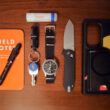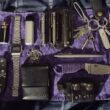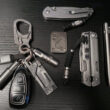A good knife is a small yet versatile companion that can make a big difference in your EDC. Individuals have cherished pocket knives for generations. Whether you’re an outdoor enthusiast, a DIY enthusiast, or simply someone who appreciates the convenience and utility of a well-crafted blade, this guide will help you understand the many different ways that people carry pocket knives.
10 Knife Carry Positions
Before you buy that new knife you’ve been eyeing, it’s essential to understand how you want to carry it. There are multiple carry positions, and making sure you get the perfect knife isn’t just about knowing what steel it’s made of or what the blade shape is; it’s also about how it’s going to fit into your EDC. Having a little foresight can go a long way when building out your carry, so let’s get into the different ways you can carry.
Inside the Waistband (IWB) Carry
Inside the waistband carry is one of the many ways to discreetly carry a knife. As you’re essentially tucking the knife inside your pants, it’s one of the best ways to conceal your blade. Typically, this is done with fixed blades that fit into a sheath on the inside of your pants waistband. You’ll want to experiment with where exactly you place the sheath so you’re comfortable with the location, but typically, you’ll want the sheath in the 3 to 6 o’clock position if you’re right-handed. This will give you easy access to your knife when needed without getting in the way of daily movements. The exact position changes depending on your preference, but that’s a good starting place.
Outside the Waistband (OWB) Tip-up Carry
Outside the waistband, tip-up carry is another way to carry a folding knife. When closed, this means that if the blade is accidentally deployed, it will point away from your stomach. This also means that when you reach to draw the knife, the handle will already be in the correct orientation, so all you need to do is deploy the blade. It’s a quick way to access your knife if speed is essential to you.
Outside the Waistband (OWB) Tip-down Carry

Pictured: Spyderco Stok
While inside-the-waistband carry is hard to beat for concealed carry, open carrying your knife on the outside-the-waistband carry is also popular. Typically, you’ll see this with larger fixed blades where it would be impractical to have it inside the waistband, but that isn’t always the case. Some people carry smaller knives on the outside of the waistband as well; it just depends on whether you’re trying to conceal or not. An OWB tip-down carry will give you the quickest draw and is the most comfortable for larger knives. This carry style also points the blade away from your stomach, which is generally safer for fixed blades.
Clip-On Bag Carry

Pictured: Lionsteel H2
As you probably guessed, clip-on bag carry is when you carry your knife clipped on your bag (or on MOLLE/PALS-compatible webbing) instead of in your pockets or waistband. This is an excellent option if you typically carry around a bag or are going to be doing an activity that requires a bag. It’s typically a go-to move for hikers as it allows you to easily carry an extra knife or offload your primary one to a more convenient spot on your bag. One thing to note is that access to your knife may be slower than on your waist as you may have to take off the bag to get to your knife, depending on where you put it. On the bright side, though, clipping a knife to your bag means you can carry multiple-size knives or knives for different use cases.
Drop Leg (Dangle) Carry

Pictured: TOPS Knives M4X Punisher
Another popular method of knife carry is the drop leg (dangle) carry. This lets you hang the knife further down your waist, typically strapped around the thigh. So whether you’re rock scrambling or just want to sit a little easier, this carry method is worth considering as drop leg carry gives you more freedom of movement. It’s also handy if you tend to carry larger fixed-blade knives as it makes it much easier to carry since you won’t need to find space in your pocket. However, it’s worth mentioning that it comes at the expense of quick access. You’ll likely be a little slow in drawing your knife when compared to waist carry. It’s also a great way to carry a secondary knife, which can be especially useful in an emergency or tactical situation.
Static Line
Static line means that your knife is anchored to you via a cord. You attach a cord to the sheath of your knife so that when you pull your knife out, you don’t need to stress about losing the sheath. A static line allows you to be flexible with where you carry your knife. You can attach your knife to your belt loop, knowing that no matter what, it’s going where you go. There might be some excess cord, which can get annoying, but as long as you get the length of the cord right and find an appropriate place to carry your knife, it shouldn’t be a problem. Just make sure you have enough line so that you can comfortably draw your knife when you need it.
Scout Carry/Horizontal Carry (behind the back)

Pictured: CIVIVI Fixed Blade Elementum
Scout carry is when you carry your knife horizontally on your belt and behind your back. By making it parallel to your belt you can keep your knife at the ready and don’t have to worry about it getting in the way when you sit or bend over. This is a solid carry method if you’re not a fan of having your knife on your front or if you already happen to have the belt real estate taken up by other tools. It’s also a good option for anyone with larger knives, as other carry positions might cause discomfort. With a scout carry knife you can draw your knife either in reverse or forward so you can get to your knife quickly. Just be careful putting the knife back when you’re done!
Neck Carry/Lanyard

Pictured: Böker Plus Gnome All Black Copper
Another common way to carry a knife is with a lanyard around your neck. Dangling a fixed blade from your neck not only gives you the option to conceal it under your shirt but also gives you quick access when you need it. However, if you decide to stash it under your shirt, you’ll spend some time getting it out first. One pro is always knowing where your sheath is when using your knife. A good, comfortable sheath is essential for neck carry as it’s the safest way to carry and can make it easier to draw your knife in a pinch.
Cross Draw Carry
Cross-draw carry is when you carry the knife horizontally on the back of your belt, chest, or across your back. Typically, the knife is canted slightly to make drawing the knife quicker and easier. This is a great method to use if you don’t have space on your belt or want to avoid attracting attention, as you can simply wear it under a shirt or jacket. Anyone who sits for long periods might prefer this method as it keeps the knife readily available even when seated.
Shoulder Strap Carry

Pictured: Survival Sheath Systems Single Shoulder Sheath
If you prefer larger fixed-blade knives, then opting for a shoulder strap carry is something worth looking into. You have your knife and sheath as part of a sling, which lets you wear it across your shoulders like a bag. Using a harness or holster also counts as a shoulder strap, though both options are typically rarer to see than the other carry options in this guide. Shoulder strap carry is a more comfortable way to carry larger knives, but it also isn’t the fastest way of drawing a knife. If you don’t think you’ll need to worry about speed, then the tradeoff might be worth it for you.
How to Pick Your Position
Dominant vs. Support
Choosing whether to carry your knife on your strong side (dominant hand) or support side (non-dominant hand) is a personal preference and can depend on various factors. Most people prefer to carry their knife on their dominant side. This allows for more precise and controlled use of the knife, making it easier to handle tasks like cutting, slicing, and carving. That said, some professions may require you to carry more than just a knife. Law enforcement officers also carry firearms and a number of other tools on their belts, in which case you may prefer to carry the knife on the support side, giving you quick and easy access to it without getting in the way. As always, knife laws differ from place to place, so stay up to date with your local regulations.
Knife Angle
Ultimately, the best knife carry angle or position depends on your specific requirements, the type of knife you have, and your comfort level. Experiment with different carry methods to find the one that suits you. You may find it more comfortable to hold the knife in reverse grip for some tasks or forward grip for others. It depends on the use case.
FAQs
Where is the best place to carry your knife?
The first thing to check is whether any local regulations limit where you are allowed to have a knife. Once you’ve checked that, you can start experimenting with where you find it most comfortable to carry a knife. Some just prefer their pockets, but there are all kinds of special sheaths and carry methods that make carrying a knife easier and give you quicker access to it.
How do you carry a fixed blade knife?
Carrying a fixed blade knife involves securing it in a sheath or holster designed for that specific knife. The sheath can be attached to your belt for convenient belt carry, worn around your neck with an adjustable lanyard, or any other carry methods we cover in this article. Consider whether you want to carry the knife openly or concealed. You should also adjust the placement for comfort and minimal interference with your everyday movements.
How do you carry a knife sheath?
There are multiple ways to carry a knife sheath, including everything from anchoring it to your belt loop or simply wearing it around your neck. You can also clip it to your pocket, bag, or just wear it on a shoulder strap or harness if it’s a larger knife.
Should you carry a knife tip up or down?
The age-old question. Ultimately, the choice between tip-up and tip-down carry depends on your individual preferences, the specifics of the knife you’re carrying, and of course your intended use case. Some people strongly prefer one orientation over the other, while others may switch between them depending on the situation.
Final Thoughts
Hopefully, you’ve gained valuable insights into how to carry pocket knives properly. A pocket knife is more than just a tool; it’s a versatile companion that can assist you in various situations. Safely carrying, using, and maintaining your pocket knife is a matter of personal safety and a show of respect for the tool itself. If you’re interested in learning more about EDC knives, check out our guide on the types of knives or the different types of locking mechanisms you’ll find on pocket knives.









